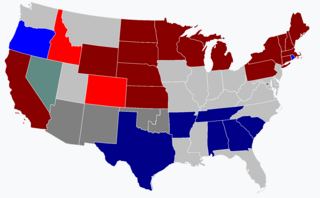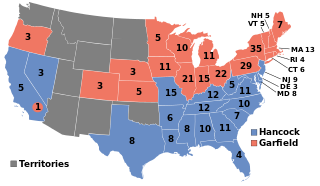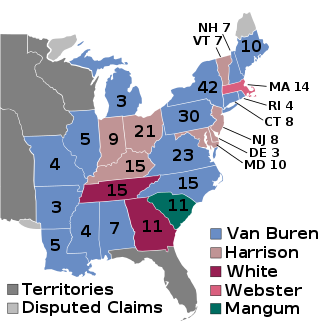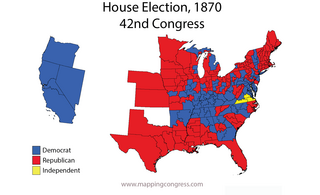
The 1916 United States elections elected the members of the 65th United States Congress. The election occurred during the Fourth Party System, six months before the United States entered World War I. Unlike 1912, the Democrats did not benefit from a split in the Republican Party, but the Democrats still retained the Presidency and the majority in the Senate. Democrats lost the majority in the House, but retained control of the chamber.

The 1914 United States elections elected the members of the 64th United States Congress, occurring in the middle of Democratic President Woodrow Wilson's first term. Democrats retained control of both houses of Congress, the first time they were able to do so since the American Civil War (1861-1865).

The 1902 United States elections elected the 58th United States Congress, and occurred in the middle of Republican President Theodore Roosevelt's first term, during the Fourth Party System. Roosevelt had become president on September 14, 1901, upon the assassination of his predecessor, William McKinley. Republicans retained a majority in both chambers of Congress, while the Populist Party and Silver Republican Party disappeared from Congress.

The 1898 United States elections occurred in the middle of Republican President William McKinley's first term, during the Fourth Party System. The elections took place shortly after the Spanish–American War. Members of the 56th United States Congress were chosen in this election. Republicans retained control of both houses of Congress.

The 1880 United States elections occurred during the Third Party System, and elected the members of the 47th United States Congress. Republicans retained the Presidency and took control of the House. An unclear partisan situation prevailed in the Senate. As the first presidential election after the end of Reconstruction, this election saw the first occurrence of the Democratic Party sweeping the Southern United States; the party would carry an overwhelming majority of Southern states well into the 20th century.

The 1860 United States elections elected the members of the 37th United States Congress. The election marked the start of the Third Party System and precipitated the Civil War. The Republican Party won control of the Presidency and both houses of Congress, making it the fifth party to accomplish such a feat. The election is widely considered to be a realigning election.

The 1836 United States elections elected the members of the 25th United States Congress. The election saw the emergence of the Whig Party, which succeeded the National Republican Party in the Second Party System as the primary opposition to the Democratic Party. The Whigs chose their name in symbolic defiance to the leader of the Democratic Party, "King" Andrew Jackson, and supported a national bank and the American System. Despite the emergence of the Whigs as a durable political party, Democrats retained the presidency and a majority in both houses of Congress.

The 1812 United States elections elected the members of the 13th United States Congress. The election took place during the First Party System, and shortly after the start of the War of 1812. The Federalist Party made a relatively strong showing, winning seats in both chambers while supporting a competitive challenge to the incumbent Democratic-Republican President. However, the Democratic-Republican Party continued its control of the Presidency and both houses of Congress.

The 1808 United States elections elected the members of the 11th United States Congress. The election took place during the First Party System. In the aftermath of the Embargo of 1807, the Federalists picked up Congressional seats for the first time since their defeat in the 1800 election. However, the Democratic-Republican Party maintained control of the Presidency and both houses of Congress.
The 1806 United States elections occurred in the middle of Democratic-Republican President Thomas Jefferson's second term, during the First Party System. Members of the 10th United States Congress were chosen in this election. Neither chamber saw significant partisan change, with the Democratic-Republicans retaining a commanding majority in both the House and Senate.

The 1830 United States elections occurred in the middle of Democratic President Andrew Jackson's first term, during the Second Party System. Members of the 22nd United States Congress were chosen in this election. The election saw Jackson's Democrats retain control of both chambers of Congress over the National Republicans and other members of the anti-Jackson faction, while the Nullifier Party won seats in Congress for the first time.
The 1850 United States elections occurred part way through Whig President Millard Fillmore's term, during the Second Party System. Fillmore had become president on July 9, 1850, upon the death of his predecessor, Zachary Taylor. Members of the 32nd United States Congress were chosen in this election. Democrats kept control of both houses of Congress.
The 1854 United States elections was the midterm election choosing members of the 32nd United States Congress during the middle of Democratic President Franklin Pierce's term. It was part of the transition from the Second Party System to the Third Party System, as the Whigs collapsed as a national party and were replaced by a coalition running on the Opposition Party ticket and the nascent Republican Party.

The 1858 United States elections occurred in the middle of Democratic President James Buchanan's term and marked the end of the transitional period between the Second Party System and the Third Party System. Members of the 36th United States Congress were chosen in this election. In the first election since the Supreme Court decided Dred Scott v. Sandford, the Republican Party won a plurality in the House, taking control of a chamber of Congress for the first time in the party's history. Although Democrats lost control of the House, they retained their majority in the Senate.

The 1862 United States elections occurred in the middle of Republican President Abraham Lincoln's first term, during the Third Party System and the Civil War. Members of the 38th United States Congress were chosen in this election. West Virginia and Nevada joined the union during the 38th Congress, but several states were in rebellion, reducing the size of both chambers of Congress. The Republican Party kept control of Congress, although it was reduced to a plurality in the House.

The 1870 United States elections occurred in the middle of Republican President Ulysses S. Grant's first term, during the Third Party System. Members of the 42nd United States Congress were chosen in this election. The election took place during the Reconstruction Era, and many Southerners were barred from voting. It was also the first election after the passage of the 15th Amendment, which prohibits state and federal governments from denying the right to vote on the basis of race, color, or previous condition of servitude, although disenfranchisement would persist. The Republican Party maintained a majority in both houses of Congress, although Democrats picked up several seats in both chambers.

The 1874 United States elections occurred in the middle of Republican President Ulysses S. Grant's second term, during the Third Party System. Members of the 44th United States Congress were chosen in this election. The election took place during the Reconstruction Era, and many Southerners were barred from voting. Colorado joined the union during the 44th Congress. Democrats took control of a chamber of Congress for the first time since the start of the Civil War, winning a huge number of seats from House Republicans. However, the Republicans retained a majority in the Senate. The election marked the first occurrence of the six-year itch phenomenon, in which a president's party lost many Congressional seats during the president's second mid-term election.

The 1878 United States elections occurred in the middle of Republican President Rutherford B. Hayes's term, during the Third Party System. It was the first election following the end of the Reconstruction Era, and Redeemers had gained back control of most Southern governments following the Compromise of 1877. Members of the 46th United States Congress were chosen in this election. Democrats won control of the Senate for the first time since the start of the Civil War. Democrats lost a majority in the House, but retained a plurality and control of the chamber.

The 1882 United States elections occurred in the middle of Republican President Chester A. Arthur's term, during the Third Party System. Arthur had become president on September 19, 1881, upon the death of his predecessor, James Garfield. Members of the 48th United States Congress were chosen in this election. Democrats won control of the House, while Republicans won control of the Senate.

The 1886 United States elections occurred in the middle of Democratic President Grover Cleveland's term, during the Third Party System. Members of the 50th United States Congress were chosen in this election. Democrats retained control of the House, while Republicans retained control of the Senate.


















